Discover the region through the decorated streets of six towns.
In the month of July, the colleagues of Passaport Marina Alta suggest that you enjoy the art that is embodied in an original way on the balconies, facades and streets of some towns in the Marina Alta. 'Walk between streets and art' is the proposal of the Marina Alta Passport, where we are invited to observe every detail of these works in the street. Four towns full of colors, music and activities for all those people who want to live a unique experience.
Marina Alta passport

You can also download and consult the complete info at the following link:
[Downloadable PDF]
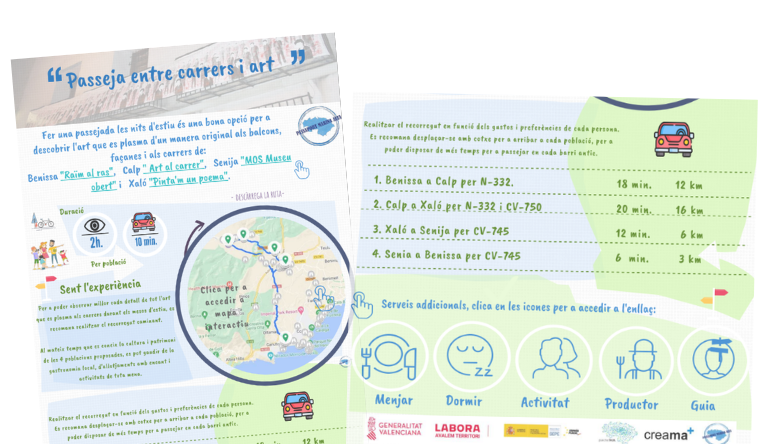
[...]
For this reason, the MACMA team put our rucksacks on our backs and went to explore it, following the directions of the Marina Alta Passport. And this was the result; stage by stage and town by town, we will reveal the history and curiosities of the places we propose on this excursion for you to enjoy too.
A BIT OF HISTORY. We know where we come from to decide where we are going.
Why do we offer this experience in July? The MACMA team suggests this month because it's when the competitions are held and the art is displayed on the streets, balconies and facades. All these initiatives have their reason, to maintain the importance of the streets, to decorate them, to celebrate and brotherhood in them.
And where does this street feeling come from? During the time that the Moorish population was in Valencian lands, neighborhoods and municipalities with narrower and more disordered streets predominated. This is due to the way of interacting and doing everyday life was of "doors towards the inside". The families were organized inside the houses and a large part of their day to day was spent at home and in the inner courtyard, mostly the women doing work. The houses of Islamic architecture gave an austere view from the outside of the house, very different from the inside, where the decoration was concentrated in the inner courtyard and in the rooms, which were oriented towards it. The courtyard was decorated with plants, trees and fountains, a work of art to admire.
This model of distribution and socialization is far from what we currently know, quite different from the conception of the Muslim population. The Christian men and women were characterized by having wider and more organized streets, where they spent their day-to-day life during the hours of the sun, they led a life of "doors to the outside". That's why the houses were always with their doors open and the streets decorated and cared for, for the Christian population it was a common space that they looked after each and every one of them.
Just as for Muslims the patio inside the house was the space where they gathered to work and socialize, and for this reason they devoted time to its decoration and covering, for Christians this community space it was the street But within these two oppositions there is a common figure, the so-called Muhtasib , a medieval Muslim official in charge of regulating trade, public baths, security and vehicle traffic. From this figure descends Mostassaf , municipal magistrate of the territories of the Crown of Aragon who was responsible both for monitoring and regulating market products and the application of urban regulations that supervised the cleanliness of the city and the activities of the guilds.
In the past, the spaces between men and women were divided. The men spent their time working in the fields and their time socializing in the bar. Places rarely frequented by women, as they were not allowed. Instead, they spent their working time in the houses where they did most of the work and in the laundry room, where they went to clean. Their place to socialize was the street, "in the cool of the night/evening" where they chatted and learned jobs such as sewing or cooking.
This way of living has been maintained over the years until our times. At this time, we can still see the influence of the figure of Mostassaf in our municipalities, especially among women.
They were the ones who looked after and maintained the street —the ones who made it an open museum and a work of art. They had as an implicit rule to clean the part of the street in front of their house, fill it with plants, and decorate it during the festivities with the best blankets hung from the balconies. Likewise, they also had myrtle on the floor. To enjoy the decoration when all the citizens dined together in the street. In addition to the street, they also took great care of the facades, beautifying them with urban elements such as doorknobs and keyholes, gutters, grates, balconies, corner guards, pylons, and absences.
All this was already urban art, on the street, on the balconies, and on the facades. These towns have created these art presentations as a tribute to our tradition, the way of living together and making brotherhood. At the same time, they give voice to the artists who, with their imagination, transform the town into an open exhibition full of history, culture, and fun.
Curiosities:
- La vetlaeta : expression used for the time when women went out into the street with their chairs to sit in the fresh air and talk, tell each other recipes, or learn to sew. Nowadays, the vigil is held by both the neighbors and the neighbors of the street when the sun sets during the summer months.
- Fer safareig: an expression that was used as a synonym for gossiping. It was called that because the laundry house was one of the places where women gathered to do housework and, therefore, a place where they could gossip.
- Enramà de la Murta is an expression they use to refer to the act carried out by the residents of the town to decorate the streets during the patronal festivities. Filling the streets with myrtle as if it were a carpet through which parades and processions pass.
PROPOSED DAYS. Step by step we are making our way.
It's summer, it's already hot and what's better than walking in the shade of the streets? Enjoy the sea breeze of Calpe and Benissa or the coolness of the mountains of Gata de Gorgos, Xaló, Senija and Benigembla.
These municipalities have chosen to transform the town during the summer months, giving visibility to the artists of our region and offering the population an unforgettable cultural and sightseeing activity. So prepare your camera and be surrounded by the inspiration of the artistic people of the region.
The experience we propose begins in Benigembla , a village in the interior of the Marina Alta, in the Vall de Pop. This year we will be able to enjoy the seventh edition of BIMAU , acronym for Benigembla Internacional - Mostra d'Art Urbà. It is a cultural revitalization project that encourages creative participation with vindictive art and the commitment to intensify the relationship between spaces and people. Different artists present their projects and apply to join this event, and a jury makes the selection. This open-air museum can be visited throughout the year, but the design, execution and exhibition of the new proposals take place during the summer. Specifically, this 2024 we can go to Benigembla from July 22 to 25 and thus see how their works of art are carried out on the facades of the towns through colors, drawings with the Ribàs theme. It is very important that when visiting this exhibition offered by the municipality of Benigembla, we do not miss a single street. We walk through each one of them, appreciating the works of art carved into the buildings, homes and shops of the town. As we tour the whole town, we will pass by different elements of the municipality that are important to highlight, such as the laundry , the church of Sant Josep or the Syndicat , an old 20th century neoclassical building, or the Ribàs botanical park , a wall built in the 20th century as a solution to the floods of the Gorgos river, becoming a symbol for the town of Benigembla and, this year with the theme that directs the exhibition. Finally, if we want to do another route through the municipality, we invite you to do the #Vadesentits route , a route prepared with several QR codes that will give you information about the history of Benigembla in a different way.
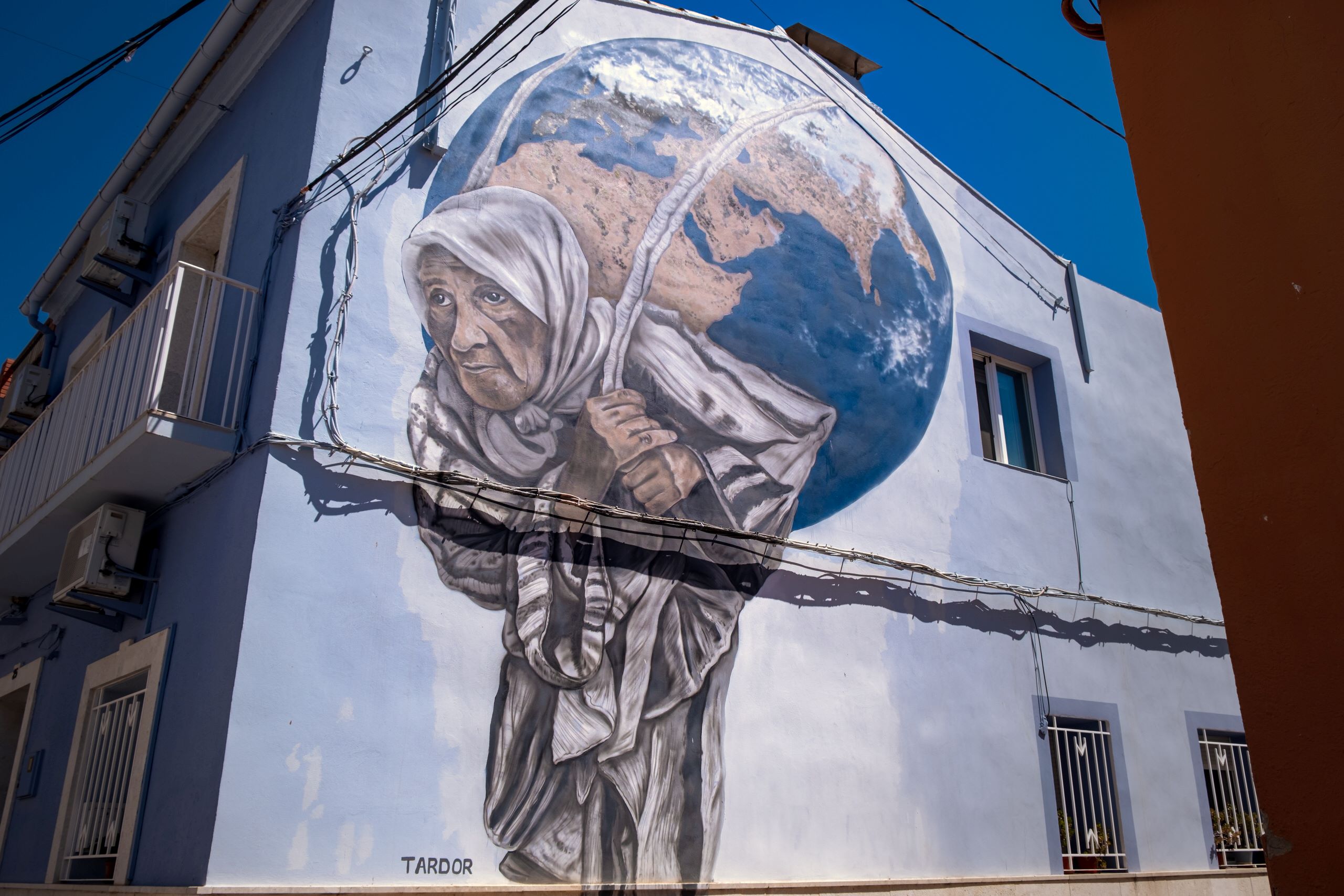
The next municipality to which we will go is Xaló , another town in the interior of the Marina Alta. In this case, the excursion we are going to take is a literary tour called Pinta'm un poema . A project born from the ideas of a group of people in love with poetry and art. A fusion of images and words, poems and visual representations that fill the walls of the municipality with life and colour. It all started as a small idea, but little by little, with the collaboration of the town hall, it has grown to become a local project, in which the people of the town and the surrounding area participate. The works, created by artists from the region, reflect excitement, solidarity and beauty framed on a wall that reaches the hearts of all pedestrians. During the tour we will be able to glimpse a total of 18 works of art that speak of love, tradition, the earth and freedom in poems such as Elegia a la Marina Alta, Vida, Terra, Dona'm la mà and much more month. This exhibition is always available to anyone curious who wants to take a walk through the streets, poetry and painting. The MACMA team recommends that, during the tour, you visit different emblematic elements of the municipality such as the Tossalet Park , the hermitage of Sant Domènec Guzman or the Ethnological and Archaeological Museum which offers a journey through the history of the different cultures and civilizations that have populated the territory of the Xaló valley. Finally, if you want to complete the #Vadesentits excursion started in the previous town, in Xaló we can continue with the urban route to interact with the five senses.

We continue with the route through the interior villages of the region, Senija . This one offers us the Open Museum of Senija - MOS , the first large open museum of the Marina Alta which since 2017 has filled the streets of Senija with colour, art and history. MOS Senija is a beautifying and enriching cultural offer for the whole family to enjoy contemporary art and the tranquility of a colorful village in the Vall de Pop. We will visit the streets of Senija at any time of the year to enjoy the works that speak of its inhabitants, their customs and devotions. A municipality full of illustrations sculpted on the facades of the houses in the village of Senija. As in the rest of the towns, we recommend visiting the Gothic arch , the town's old fountain , the church of Santa Caterina or the Rock of the Salve , a monument commemorating the people who went to La Ribera to work the rice . This last emblematic element is located inside the village schools, which is why it can only be seen from outside or when they are open to the public. Finally, we will close the visit to this town by traveling through the history of Senija, getting to know all its corners with the sensory route #Vadesentits .
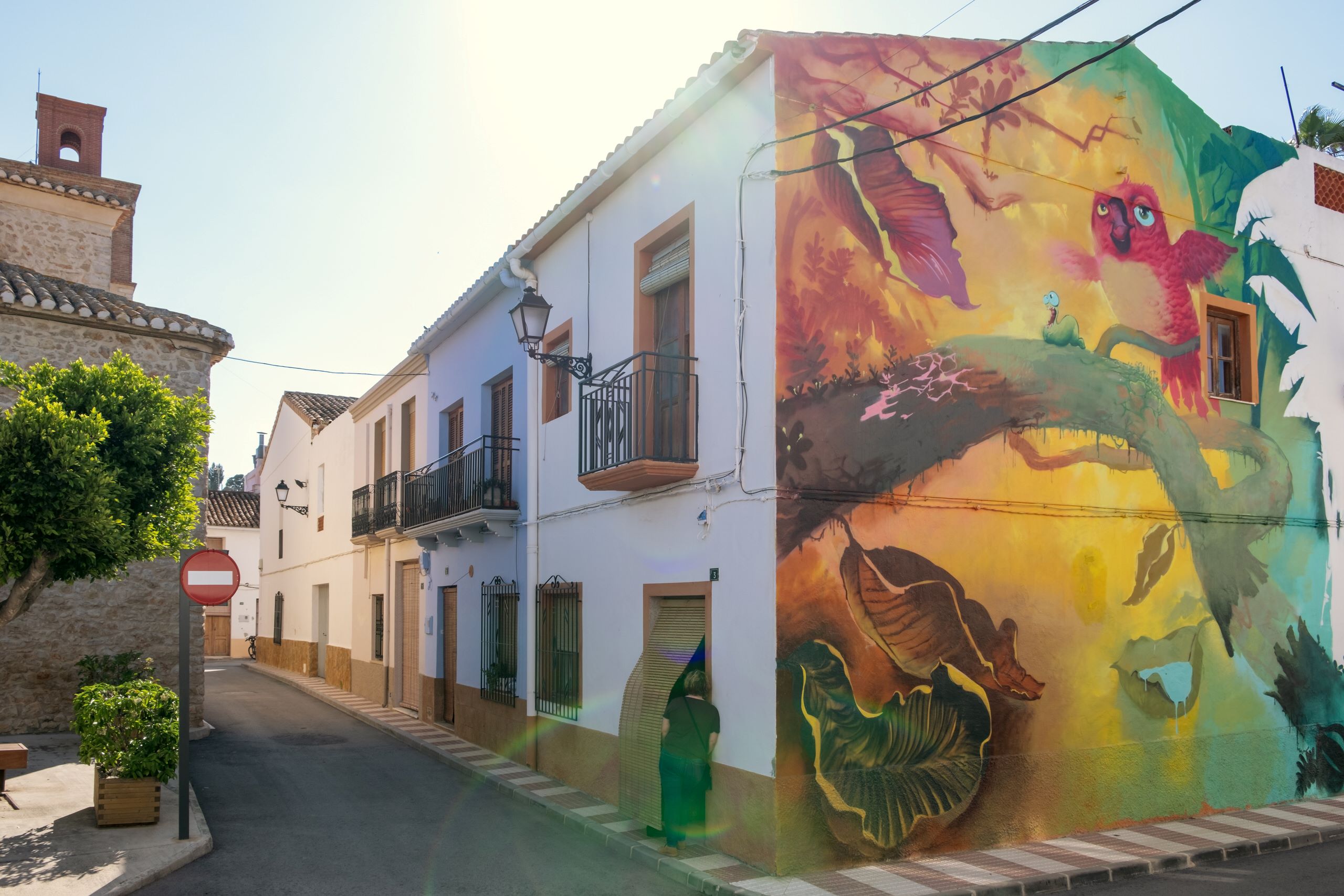
On the second day of the experience, we begin our proposal with a visit to an outdoor exhibition of textile art that takes place in Gata de Gorgos , from June 28 to July 21 in the street the bass As we talked about before, it is a tradition to hang the best blankets on the balconies to decorate the streets during the festivities and in Gata de Gorgos this tradition has remained very alive over time. For this reason, the conclusion was reached to continue maintaining this, but in a different way, fusing it with textile art and finally it was called Art in the wind . These hanging works have the dimensions of bedspreads and are made almost 100% of fabric with the aim of offering visitors the fluid dance of the fabrics with the wind that runs through the street. We will enjoy an exhibition on a whole street accompanied by a varied cultural program with activities throughout the month, dance, presentations, performances, music, an exhibition with posters from twenty years of Art in the Wind and many other events. In addition, if what we want is to extend the visit around the town, we recommend visiting the Creu de Tosca , a carved stone cross that demarcated the village, the church of Sant Miquel d'Arcàngel or doing the Ruta dels Riuraus XIII for continue delving into the tradition of the Valencian lands.
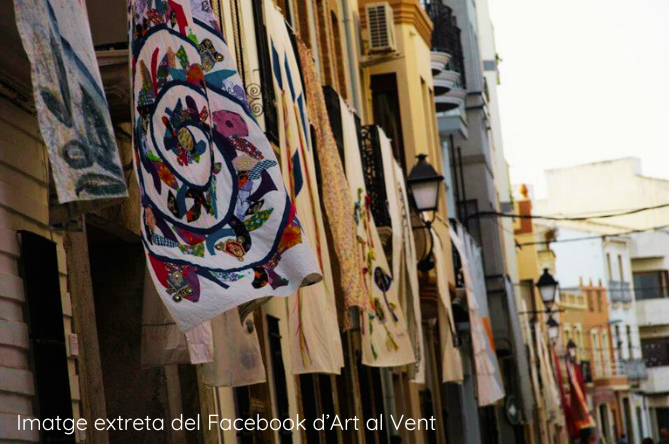
The second town of this day and the penultimate of the July experience is Benissa . We continue with street exhibitions during the summer months and in this town we propose Art al Ras . For many years, this municipality has been one of the towns in the region that made artistic interventions in the street, but one year, due to issues with the pavement, it was stopped. This event did not resume until the residents and artists of Benissa met and decided to protest the stop of this cultural event. The best way to claim was to do this event again and with the help of Grup d'Artistes de Benissa (GAB) and the neighborhood they have organized to do this cultural and artistic event again on an annual basis. A different exhibition, with paintings, music, and many figures that follow a common theme. In previous years, the themes have been cans and grapes, two products closely linked to the town. This year we will be able to enjoy both group works and individual works that deal with the subject of threads. The exhibition will open on July 5 and will be on display until September 8 under the name ' Fils al Ras '. Taking advantage of the visit to the town, we recommend going into each street and each emblematic element of the municipality to have a full experience of Benissa. Some elements we recommend such as the laundromat , the Council Chamber , the Batlle Houses and the square of the old church . A town full of charm and tradition.

Finally, the MACMA team wants to close this enriching experience with an exhibition in the historic center of a coastal town, Calpe . The cultural and artistic event that this municipality holds during the summer months to fill the decorated streets with visitors perplexed by the art that covers this coastal town, called Art al Carrer . This year the inauguration will be on July 18 with this activity in which associations and entities from Calpe participate to promote associative life and make convoys between friends and family. This year's artistic decorations are based on the motto of Calp marinero , a theme that includes one of the most important aspects of the town, the sea. Works of art that we expose to the street to admire a critical look mixed with customs and beauty. In addition, to complement the visit to this town, we can visit the salt pans , the red wall which is a construction with a topography adapted to the cliff, the salt well , the hermitage of Sant Salvador and the church of the Virgin de les Neus or Torreó de la Peça , named after the remains of the military architecture of the fortress.
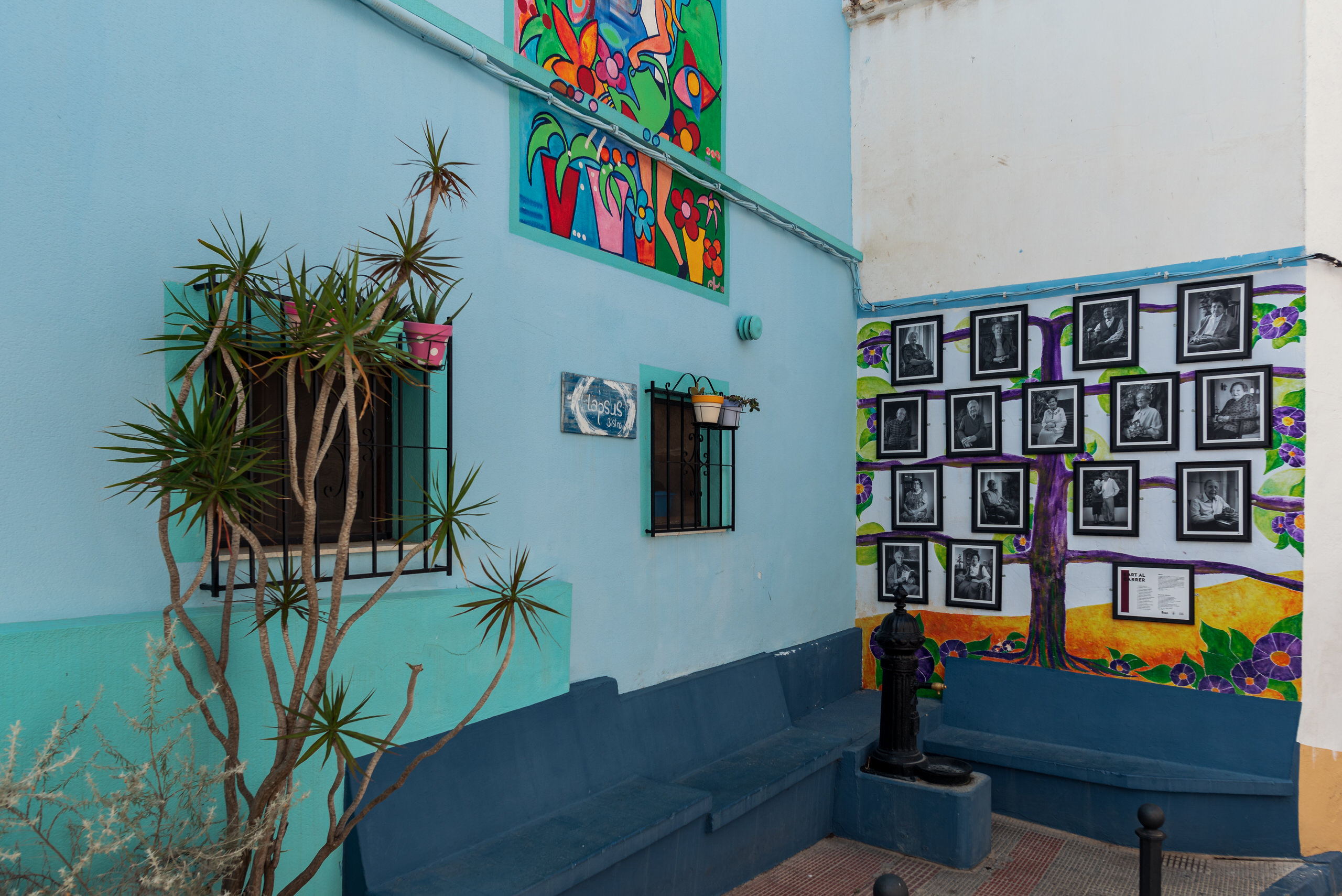
A month full of street events, dances, music, crafts, exhibitions, talks, and much more. A flurry of activities scheduled to celebrate the good weather with art and make brotherhood by taking advantage of the coolness of the sunset. If you want to find out about all the activities that are scheduled for this month of July, consult all the cultural, youth and sports programming in our MACMA Guide and enjoy the summer with friends and family.
** This experience is designed to be done on different days to enjoy the exhibitions and all the activities of the municipalities. From the MACMA we recommend that the route be done in the evening, with the sun setting, as this is where we can most enjoy the freshness of the wind that runs through the streets. Similarly, each person can adapt the experience according to their tastes and take a look at the cultural program of each of these municipalities. In addition, if what you want is to expand the information or elements to visit in each town, you can go to the Descobrim la Marina Alta web page and customize this route.
You can follow the July experience using this map.

AND MORE. On the table and in bed at the first cry.
 Where to buy |  where to eat |
 where to sleep |  Activities and others |